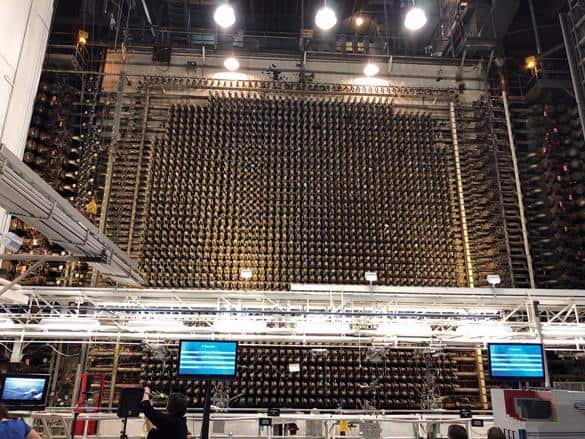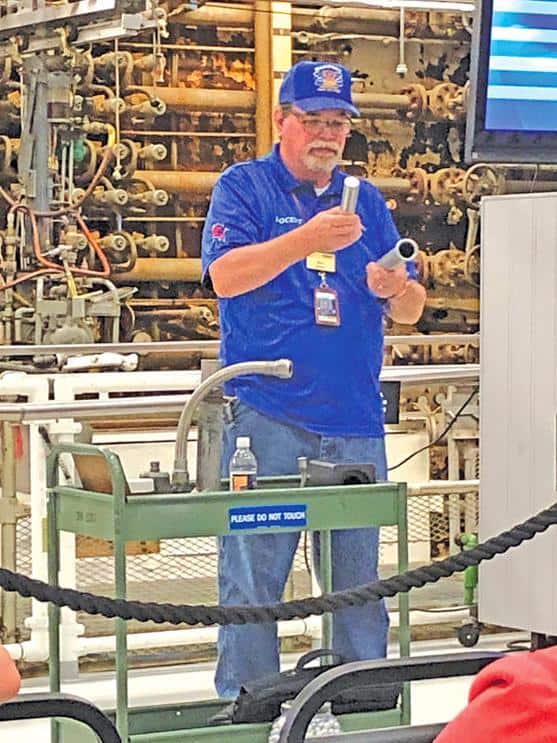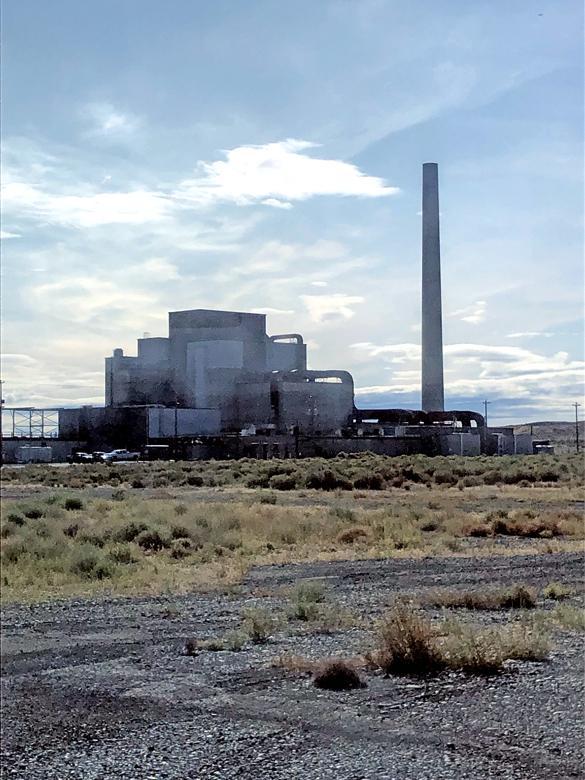 Front face of the four-story reactor. Photo by Heather McClenahan
Front face of the four-story reactor. Photo by Heather McClenahan
 Docent Bert explaining how the reactor worked by using hands-on objects. Bert took an Atomic City tour with Georgia Strickfaden last October and said he loved his visit to Los Alamos. Photo by Heather McClenahan
Docent Bert explaining how the reactor worked by using hands-on objects. Bert took an Atomic City tour with Georgia Strickfaden last October and said he loved his visit to Los Alamos. Photo by Heather McClenahan
By Heather McClenahan
Los Alamos Historical Society
As the former executive director of the Los Alamos Historical Society, I twice had the privilege to visit the B Reactor in the Tri-Cities area of Washington.
The B Reactor is where the plutonium for the Trinity Test and the Nagasaki bomb was produced in World War II. The expansive Hanford site, with its nine nuclear reactors, had a huge role in the Cold War as well.
When the non-contiguous Manhattan Project National Historical Park was created in 2015, with sites in Los Alamos, Oak Ridge, and Hanford, the B Reactor would serve as the center piece of the park’s Hanford unit. Tours conducted by volunteers, with the assistance of the Department of Energy, had been going on for years, but suddenly, they would be integral to the National Park Service’s interpretation of the site.
Many of the docents are former employees, and their passion for the work that went on at the reactor, as well as their technical and historical knowledge, is unparalleled.
Last week, I was able to visit the B Reactor as a tourist, along with my husband, a retired engineer from the Los Alamos National Laboratory. He was a bit like a kid in a candy store, asking highly technical questions about everything from radioactivity to water pressure, questions to which the docents and onsite staff always had answers.
The tour begins at a small visitors’ center on the outskirts of Richland, Washington. Historic photographs and information about the site offer context and perspective with just enough details to be tantalizing. After a short video telling why Hanford was chosen as the site for World War II plutonium production and explaining some of the work that went on there, visitors board a bus for a 45-minute ride to the reactor.
Through the arid countryside, part of the Hanford Reach National Monument, the docents tell stories of the region’s flora and fauna, Native American history, and the history of early farming communities whose lands were taken for the Manhattan Project.
At the reactor, we walked in and were awed by the four-story front face of the world’s first full-scale plutonium production reactor. It’s breathtaking. A short video explains how the reactor was constructed, and models around the room provide excellent details.
A well-trained docent uses hands-on objects to explain how the reactor functioned, how workers refueled it, and what happened to the plutonium once it was made. It’s a bit of a chemistry and physics lesson, but it is told for lay people in a way that even a couple of young people on the tour, who were working on their Junior Ranger badges, could get some understanding. Visitors are free to walk around the sprawling complex to view historic sites like the control room, Enrico Fermi’s office, and the valve room where tens of thousands of gallons of water from the Columbia River flowed into the plant to cool the reactor. Historic photographs dot the walls, as do authentic safety signs from the site’s history.
Like Los Alamos, the Hanford site still has an active national facility, Pacific Northwest National Laboratory.
In addition to work with nuclear energy and materials science, PNNL scientists invented the technology that led to the development of compact discs and created processes to turn agriculture wastes into useful methane fuel.
The B Reactor is in the heart of Washington wine country, with the Yakima River watering bountiful vineyards that supply nearly 200 wineries. That’s another of many reasons the area is a great place to visit. For those of us from Los Alamos, connection to the history makes the visit priceless.
The B Reactor tours run on selected dates April through November. Signing up online is easy and free. Go to https://manhattanprojectbreactor.hanford.gov/ and follow the links.
 Exterior of the B Reactor. Photo by Heather McClenahan
Exterior of the B Reactor. Photo by Heather McClenahan

